It's a rare and highly symbolic occurrence that history marks with reverence: A leader of a nation, once at hot or cold war with the other, ventures into enemy territory.
Every effort is made to lay on a glittering welcome — and the hosts' intelligence services might also enjoy a tangible boon. The visitors take a gamble and concede home field advantage, something far beyond the comfort zone for many of the leaders, and statesmanship becomes the name of the game.
The outcome can lead to a geopolitical gain or simply fade away.

FILE - In this Sept. 23, 1959, file photo, Soviet Premier Nikita Khrushchev and Roswell Garst pose with corn cobs during an inspection tour of The Garst Farm in Coon Rapids, Iowa. Khrushchev became the first Soviet leader to visit the U.S. He traveled to Washington, New York, California and Iowa and held meetings with President Dwight Eisenhower. (AP PhotoFile)
This week's trip by South Korean President Moon Jae-in to the capital of North Korea may appear to have less impact to some outside the region after a series of meetings by North Korean leader Kim Jong Un since April. But the denuclearization stakes are high, with the Trump administration watching closely.
A look at some of the most striking examples of a leader heading into what their own nation would consider the lion's den.
KHRUSHCHEV IN THE UNITED STATES
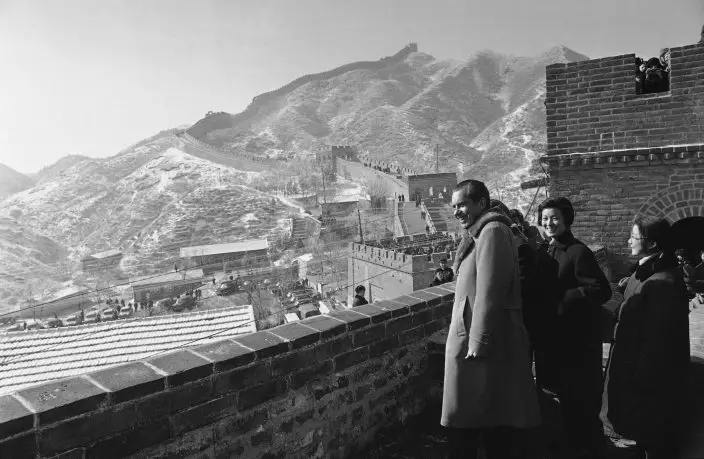
FILE - In this Feb. 24, 1972, file photo, President Richard Nixon, with Chinese guides and interpreters, stands on the Great Wall of China outside Peking. Richard Nixon made the historic journey to meet Chinese leader Mao Zedong in part paved by a U.S. pingpong delegation that traveled to Beijing a year earlier. (AP PhotoFile)
In 1959, as the Cold War took hold but two years before the Berlin Wall was erected and three years before the Cuban missile crisis, Nikita Khrushchev became the first Soviet leader to visit the U.S. He traveled to Washington, New York, California and Iowa, meeting with President Dwight Eisenhower. Hopes that the trip would pave the way to even a quasi-normalization of relations and a thaw in tensions were not realized, however.
SADAT IN JERUSALEM
When Egyptian President Anwar Sadat visited Israel in 1977, it signaled a new beginning for the battle-weary nations that would transform the region. After decades of animosity and just four years after a war, Sadat came with a historic offer of peace and addressed the Knesset. Not all were enthralled with the visit. Libya's Moammar Gadhafi said at the time that Egypt would be sent back a corpse. The visit set the tone for the Camp David peace treaty in 1979 in Washington. Sadat was assassinated in Cairo in 1981 by homegrown Islamic militants.
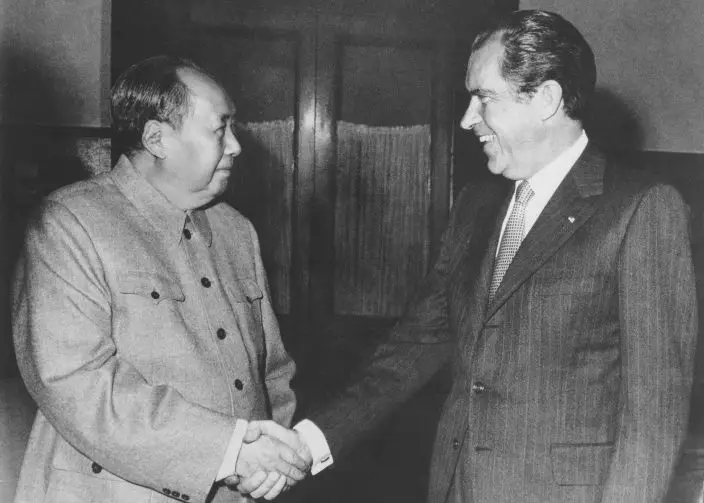
FILE - In this Feb. 21, 1972, file photo, Chinese communist party leader Mao Zedong, left, and U.S. President Richard Nixon shake hands as they meet in Beijing, China. Nixon made the historic journey to meet Chinese leader Mao Zedong in part paved by a U.S. pingpong delegation that traveled to Beijing a year earlier. Their historic handshake was as much about countering the Soviet threat as building trade and cordial relations between the two countries. (AP Photo, File)
NIXON IN CHINA
In 1972, President Richard Nixon made the historic journey to meet Chinese leader Mao Zedong in part paved by a U.S. pingpong delegation that traveled to Beijing a year earlier. The U.S. and China had fought only 20 years earlier on opposing sides of the Korean War. Their historic handshake was as much about countering the Soviet threat as building trade and relations between the two countries. China felt directly threatened by the Soviets at the time, and Nixon was thought to have parlayed the nascent relationship as a counter to Moscow over arms control talks.
AT THE UNITED NATIONS
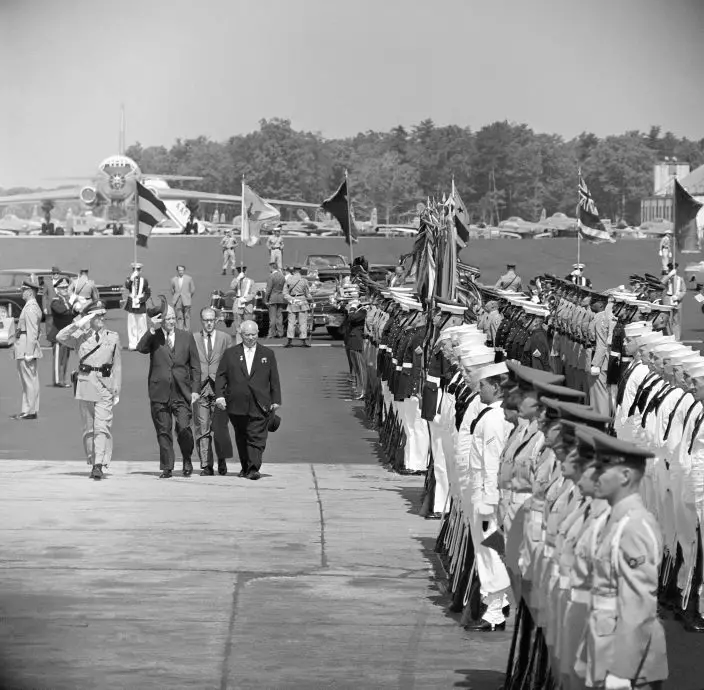
FILE - In this Sept. 15, 1959, file photo, United States President Eisenhower accompanies Soviet Premier Nikita Khrushchev as he inspects the line of honor guards at Andrews Air Force Base following his arrival. Khrushchev became the first Soviet leader to visit the U.S. (AP PhotoFile)
Several key U.S. adversaries have made it to American soil — not for a summit but under the auspices of the U.N. General Assembly. Fidel Castro came several times. The spectacle of his first visit to New York in 1959 gave away to subsequent visits as an effective enemy of the state railing from the U.N. at those he characterized as his country's capitalist oppressors. The late Venezuelan leader Hugo Chavez drew gasps at the U.N. in 2006 when he said of U.S. President George W. Bush, "yesterday, the devil came here," adding that the podium "still smells of sulfur." And Iran's hard-line former President Mahmoud Ahmadinejad in 2010 questioned whether the Sept. 11 attacks were staged.
THE ROAD TO PYONGYANG
In 2000, Kim Jong Il, the late father of North Korea's current leader, smiled broadly as he shook hands with South Korea's then-president, liberal Kim Dae-jung at Pyongyang airport, and they agreed to resume family reunions and joint economic projects. In 2007, Kim Jong Il met Roh Moo-hyun, Kim Dae-jung's successor and the current president's political mentor. Roh crossed the Demilitarized Zone and met with Kim in Pyongyang. There, they agreed to pursue a peace treaty to formally end the Korean War, but most of the accords and projects were shelved.

FILE - In this Nov. 20, 1977, file photo, Egyptian President Anwar Sadat, standing, shakes hands with Israel Prime Minister Menachem Begin in the Israeli Parliament, after Sadat addressed the Knesset. At right is chairman of the Parliament, Yitzhak Shamir, applauding. After decades of animosity and just four years after a bitter war, Sadat came with a historic offer of peace. (AP PhotoShmuel Rachmani, File)

FILE - In this Nov. 21, 1977, file photo, Egyptian President Anwar Sadat is flanked by Israeli Labor Party leader Shimon Peres, right, and former Israeli Prime Minister Golda Meir, in the Israeli Parliament building, in Jerusalem, as they listen to former Israeli Prime Minister Yitzhak Rabin, left, at microphone. After decades of animosity and just four years after a bitter war, Sadat came with a historic offer of peace. Not all were enthralled with the visit. (AP PhotoFile)
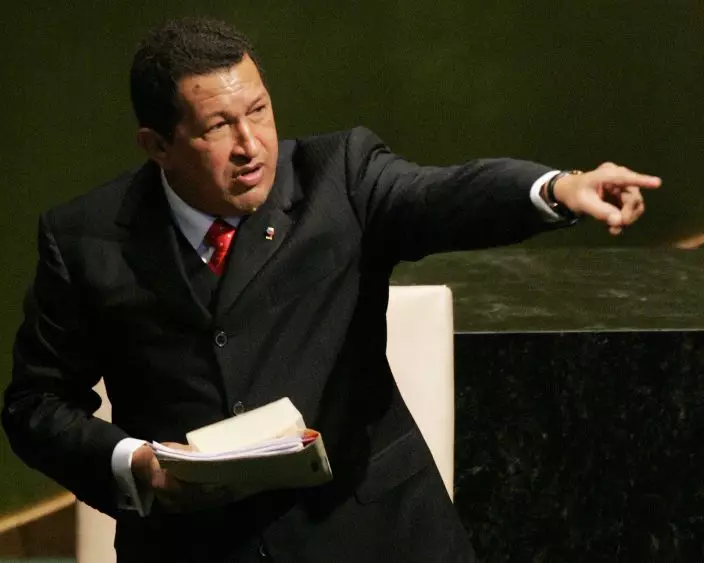
FILE - In this Sept. 20, 2006, file photo, Venezuela's President Hugo Chavez acknowledges members of the 61st session of the United Nations General Assembly at U.N. headquarters. Chavez drew gasps at the same forum in 2006 when he said of U.S. President George W. Bush, “yesterday, the devil came here,” adding that “it still smells of sulfur today.” (AP PhotoJulie Jacobson, File)
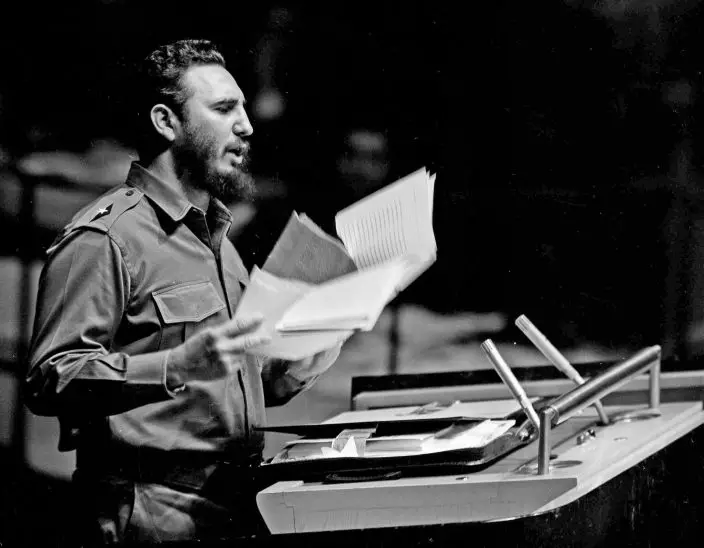
FILE - In this Sept. 26, 1960, file photo, Cuban Premier Fidel Castro waves a document during his talk to the United Nations General Assembly. The sheen and spectacle of his first visit to New York City in 1959 gave away to subsequent visits as an effective enemy of the state railing from the U.N. podium at those he characterized as his country’s capitalist oppressors. (AP PhotoFile)

FILE - In this April 24, 1959, file photo, Cuban Prime Minister Fidel Castro waves to crowd in New York's Central Park. The sheen and spectacle of his first visit to New York City in 1959 gave away to subsequent visits as an effective enemy of the state railing from the U.N. podium at those he characterized as his country’s capitalist oppressors. (AP PhotoJohn Rooney, File)
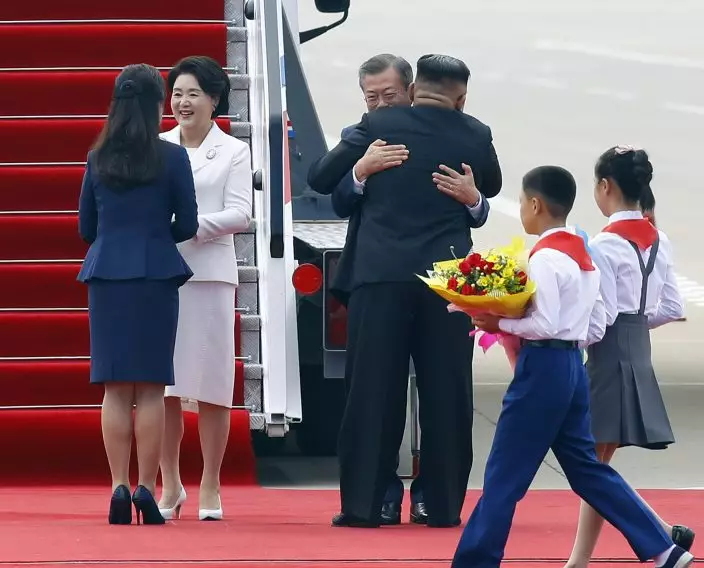
South Korean President Moon Jae-in, third from left, and his wife Kim Jung-sook, second from left, are welcomed by North Korean leader Kim Jong Un and his wife Ri Sol Ju upon their arrival at Sunan International Airport in Pyongyang in North Korea, Tuesday, Sept. 18, 2018. (Pyongyang Press Corps Pool via AP)


